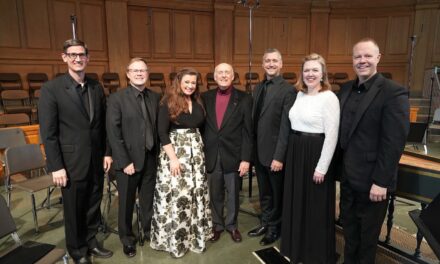Deep and profound relationships exist between Viennese composers Gustav Mahler (1860-1911) and Alban Berg (1885-1935). Berg not only looked to his older compatriot for models for his own music, but another connection came in the form of Mahler’s widow, Alma Mahler. After Gustav died, Alma married the architect Walter Gropius, and they had a daughter, Manon. Tragically, she died before she was 19, and the event shook Berg, who responded by composing one of most notable pieces in the 20th century literature: his Violin Concert, which carried the inscription “In Memory of an Angel.” When Berg died, it was Gustav and Alma’s daughter, Anna, who made the death mask.
Thus the North Carolina Symphony’s performance linking Berg’s Violin Concerto with Mahler’s Symphony No. 4 makes perfect sense. Add to these two works Magnus Lindberg’s Chorale (2001-2002) and the listener had an evening of rich associations. Lindberg (born in Finland in 1958) wrote his 10-minute orchestral piece as a “companion piece” to the Violin Concerto, since both make use of the chorale (hymn) “Es ist genug!” from Bach’s Cantata No. 60.
Music Director Grant Llewellyn spoke to the disappointingly small audience before launching into the program, translating the text of Bach’s chorale and pointing out motifs the listener might hear. Lindberg’s use of the chorale melody is ever present in the musical texture, starting in the brass, but eventually finding its way into every nook and cranny of the orchestra. Sometimes the strings provide an ethereal halo surrounding the tune. One can certainly hear Berg-influenced thick orchestration, where dissonant clusters eventually give way to more consonant sonorities.
Berg’s Violin Concerto makes intense demands on both the listener and the musicians. The audience needs to be prepared for extreme dissonance and thick tangles of sound as well as soaring lyrical sections; it is a work with rewards that come only with multiple listenings. The concerto consists of two parts, each of which contains two sections that contrast by tempo; the soloist was NC Symphony Concertmaster Brian Reagin.
The opening motive, articulated by the violinist playing his four open strings, is slowly transformed into the 12-tone tune that is the basis for the entire work. Like the preceding piece by Lindberg, orchestration is a key to some of the beauty of the work — often the orchestra serves as a type of pillow for the solo line; other times the two battle against each other in violent rhythmic passages. The conclusion, however, is radiant, with the violin ascending to heavenly heights accompanied by colorful orchestral clouds.
Reagin was a superb advocate for this thorny work. He made his violin sound miraculously transform to capture the ethereal heavenly passages, the sections that depict hellish struggle, and everything in between. While he may not be the most overtly dynamic performer, his heart-felt playing caught the intensity of the score, and his technical ability was more than ample for the fiendishly difficult double-stops with pizzicatos and manic changes of register and rhythm. Conductor Llewellyn focused on overall sound, coaxing the large orchestra to play with passion and intensity.
Mahler’s Fourth Symphony is a rather relaxed composition in comparison to the previous two works. The first three movements are instrumental, but the fourth brings a soprano into the proceedings, singing “Das Himmlische Leben” (“The Heavenly Life”), a child-like vision of the goings-on in the afterlife.
The first movement begins distinctively with sleigh bells, which are used at important points in the movement. The cheery mood is taken up by several tunes. To be sure, the jocular nature is broken by a couple of cataclysmic climaxes (this is Mahler, after all) but good humor closes out the movement.
The dance-like second movement is distinguished by the sound of a solo violin, animatedly played by Associate Concertmaster Dovid Friedlander. The fiddle is tuned a step high, thereby heightening the diabolical aspect of this scherzo. Conductor Llewellyn took the slow third movement at a wonderful tempo that was in no hurry to get anywhere, but allowed the audience to enjoy the beauty of the unfolding melodic line.
Soprano Christina Pier joined the ensemble for the finale, which is a delight of melody and orchestral color. Pier’s rich voice beautifully projected the text with clear diction, and her expressive singing soared. Lllewellyn paid close attention to the singer’s direction and intent, and ensemble between orchestra and solo was right on.
Mahler’s score calls for many solos throughout the orchestra — clarinet, flute, horn and many more where played with distinctive character. However, ensemble was not as tight as would be expected; winds and brass entrances were splattered on several occasions throughout the night. The overall sound of the string section was unified in intent and timbre, and the brass and winds’ sound was solid.











